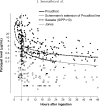Prediction of outcome after paraquat poisoning by measurement of the plasma paraquat concentration
- PMID: 19228776
- PMCID: PMC2659600
- DOI: 10.1093/qjmed/hcp006
Prediction of outcome after paraquat poisoning by measurement of the plasma paraquat concentration
Abstract
Background: Paraquat is a herbicide with a good occupational safety record, but a high mortality after intentional ingestion that has proved refractory to treatment. For nearly three decades paraquat concentration-time data have been used to predict the outcome following ingestion. However, none of the published methods has been independently or prospectively validated. We aimed to use prospectively collected data to test the published predictive methods and to determine if any is superior.
Methods: Plasma paraquat concentrations were measured on admission for 451 patients in 10 hospitals in Sri Lanka as part of large prospective cohort study. All deaths in hospital were recorded; patients surviving to hospital discharge were followed up after 3 months to detect delayed deaths. Five prediction methods that are based on paraquat concentration-time data were then evaluated in all eligible patients.
Results: All methods showed comparable performance within their range of application. For example, between 4- and 24-h prediction of prognosis was most variable between Sawada and Proudfoot methods but these differences were relatively small [specificity 0.96 (95% CI: 0.90-0.99) vs. 0.89 (0.82-0.95); sensitivity 0.57 vs. 0.79, positive and negative likelihood ratios 14.8 vs. 7.40 and 0.44 vs. 0.23 and positive predictive values 0.96 vs. 0.92, respectively].
Conclusion: All five published methods were better at predicting death than survival. These predictions may also serve as tools to identify patients who need treatment and for some assessment to be made of new treatments that are trialled without a control group.
Figures


References
-
- Lock EA, Wilks MF. Handbook of Pesticide Toxicology. 2nd edn. San Diego: Academic Press; 2001. Paraquat. pp. 1559–603.
-
- Eddleston M. Patterns and problems of deliberate self-poisoning in the developing world. QJM. 2000;93:715–31. - PubMed
-
- Jones AL, Elton R, Flanagan R. Multiple logistic regression analysis of plasma paraquat concentrations as a predictor of outcome in 375 cases of paraquat poisoning. QJM. 1999;92:573–8. - PubMed
-
- Proudfoot AT, Stewart MS, Levitt T, Widdop B. Paraquat poisoning: significance of plasma-paraquat concentrations. Lancet. 1979;2:330–2. - PubMed

